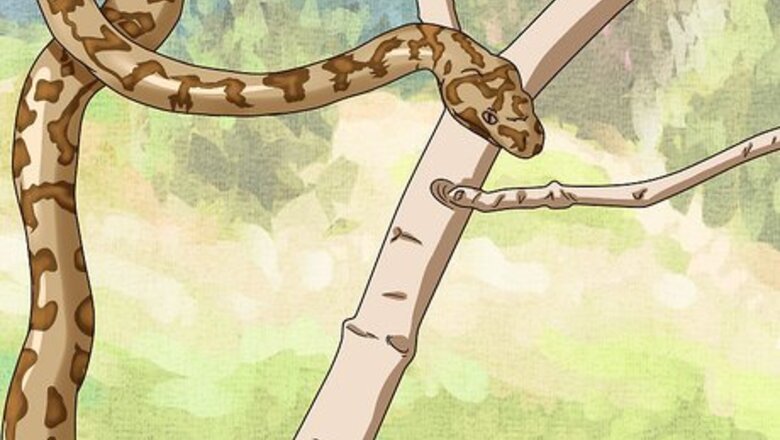
views
Playing With Your Snake

Provide room to exercise. Most snakes are not very social animals. For the most part, they prefer to be left alone, and do not always enjoy the company of people or other animals. However, there are some ways that you can constructively interact with your snake. Most snakes do enjoy moving around. Make sure that you offer your pet the option to exercise. Some larger snakes enjoy swimming. If possible, provide a small pool, such as a kiddie pool, for your snake to swim in. Snakes also like to climb. Consider getting a climbing pole or artificial tree to place in your home. Your snake does not need unlimited access to exercise facilities. But your pet will enjoy coming out of his cage to move around a few times a week.

Find the best toys. Your snake doesn't need a lot of expensive toys to enjoy playing. One of a snake's favorite activities is curling around a long object. You can look in your yard or a local park to find a suitable material. The size of branch that you want depends on the size of your snake. Snakes like to wrap their bodies around objects. Look for a stick or branch that is at least 1 foot long, or larger, if you have a large snake. Make sure it is sturdy enough to support your snake. You can allow your snake to play even when you're not around. Look for a small log to place in his cage. He will enjoy winding around it.
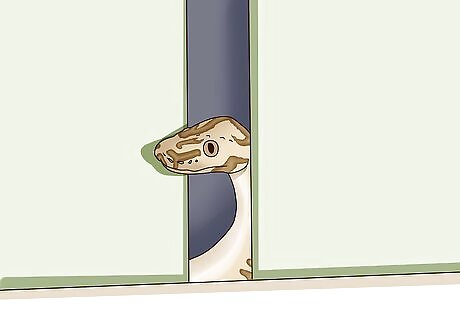
Play "hide and seek". Snakes love this game, although they generally only participate in the hiding part. It's natural that you want to spend quality time with your pet. Just remember that you want play time to be enjoyable for the snake, too. Take care to make sure that you choose a suitable place for your recreational activities. The majority of snakes do not enjoy being around multiple people. Even though you might enjoy showing your pet off to a group of your friends, remember that is not enjoyable or comfortable for your snake. Choose a quiet room to play with your snake. Some snakes like to play a version of "hide and seek". If your home has a secure room, allow your snake to roam free in that room. He will likely find somewhere to hide, like behind some furniture. You can then find him. Make sure that your snake cannot escape from the room. You don't want to lose your pet during your game.

Monitor reactions. Snakes have personalities. They have their own likes and dislikes, just like people. Get to know your snake so that you can tell whether or not both of you are enjoying play time. Remember that most snakes don't really like to be touched. Your pet will probably most enjoy playing if he is able to do so independently. If you are playing with your snake, pay attention to his mood. If he seems to be showing signs of discomfort, let him go back in his cage. If your snake strikes out at you, that is meant as a warning. You should give him some space. Hissing can also be a sign that your snake would prefer to be left alone. Respect his need for alone time.
Keeping Yourself and Your Snake Safe
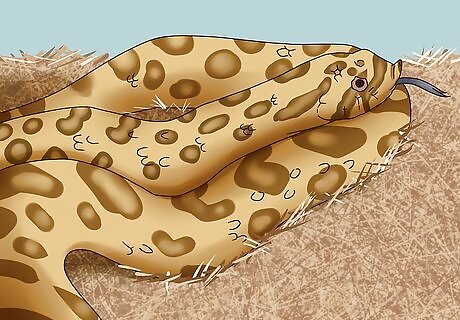
Choose the right snake. When you decide to get a pet snake, it is important that you choose the right one. There are several kinds of snakes that make good pets. Think about your priorities when choosing the one that is right for you. The larger the snake, the more space you will need. If your home has limited room, look for a smaller snake. If you are not an experienced snake owner, you need a snake that is easier to handle. Don't immediately try to get a large snake with a bad temper. Corn snakes are among the most popular options. They usually grow to less than 6 feet long, and they are even tempered. The king snake is also a good choice. They adapt very well to living in captivity.
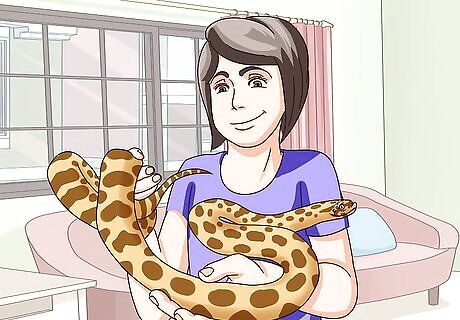
Teach your kids to play with your pet snake. If you are going to keep a pet snake, it is important that each member of your household learn to care for the snake. It's a good idea to teach your children to learn to properly care for the snake. This will help them remain safe when they play with their pet. Remind your kids that snakes are not toys. They are living creatures and it is important to treat them respectfully. Pets are great because they can help teach your kids responsibility. Use feeding times to teach your kids the importance of sticking to a routine. Snakes are fairly low-maintenance, so they can work well for kids. There is no hair or fur to clean up, and they don't need to be walked. If you have kids, consider getting a corn snake or ball python. If they do bite, the wound won't be severe.
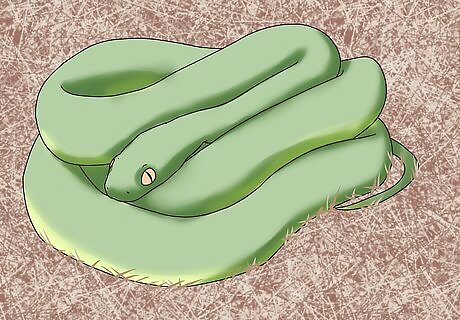
Respect hibernation. Part of keeping your snake safe means paying attention to physical needs. Some snakes require regular periods of hibernation. This occurs most often in the winter. Provide your snake a proper environment for hibernation. Keep the room cool and dark. If your snake is hibernating, do not try to handle him. It is not the right time to play. For the most part, leave your snake alone during hibernation. How long it lasts will depend on what type of snake you have. Just remember to check on him regularly and supply fresh water.
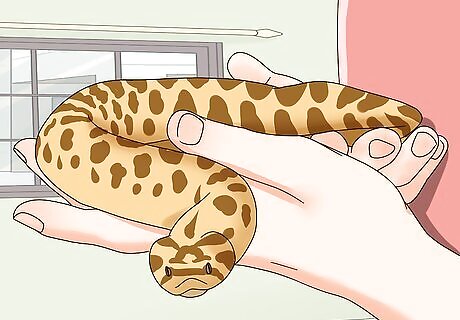
Handle your snake carefully. Most snakes prefer not to be handled regularly. But if you make a habit of gradually getting your pet used to being held, many will adapt. Just make sure to use the right technique. Hold your snake firmly but gently. Make sure most of the body is supported. Your snake will often tolerate being held, but that doesn't mean he will enjoy it. Your snake will let you know when to put him down by struggling or squirming. Do not hold your snake for 48 hours after a feeding. He needs time to digest his meal. If your snake is moved to a new environment, give him time to adjust. Avoid handling your pet for 5-7 days.
Caring For Your Pet Snake
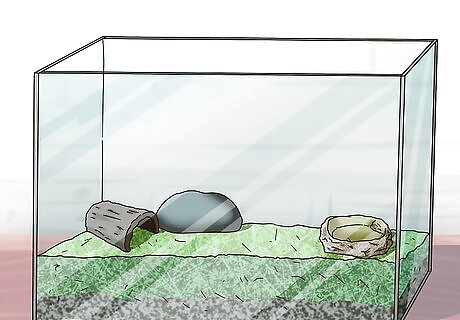
Provide a comfortable home. Your snake needs a comfortable home in order to be happy and healthy. Make sure to clean the cage on a regular basis. You should also make sure that you get the proper size of enclosure. Small snakes, such as garter snakes, can happily live in a 10-20 gallon aquarium. King snakes will be fine in 30-55 gallon tanks. If you are going to keep a large snake, such as a python or boa constrictor, you will need to get a custom cage. These snakes can become very large, so average pet stores do not sell cages for them. Provide a log for the snake to hide in. A fake log will work just as well as a real one.

Monitor the temperature. Snakes, like all reptiles, must live in an environment with an optimal temperature. Snakes are not able to heat themselves the way mammals do, so you will need to provide heat sources. The best temperature depends on which type of snake you have. Corn snakes, for example, should be kept at 75-85 degrees. A ball python will enjoy basking in a spot between 88-96 degrees. Provide more than one heat source. Consider using a heat lamp and an under the tank heating pat. You can purchase both at pet stores. You can use a thermostat to monitor your snakes environment. Make sure all of your heating equipment remains in working order.

Feed your snake well. Snakes are well-suited for living in captivity. It is easy to provide them with all of their nutritional needs. Most snakes live on a diet of insects and rodents. It is a good idea to feed your snake rodents that are already dead. You can buy frozen mice at most pet stores and keep them on hand. Just make sure to thaw thoroughly before feeding to your snake. If you have a corn snake, it will happily eat every about every 10 days. If your snake doesn't eat within 10-15 minutes of being offered food, remove it. He is not interested. A ball python will usually eat every 10-14 days. Don't worry if your snake refuses a meal or two. That is normal. Snakes rarely drink, but it is important to keep fresh water in the cage. They need the moisture to keep their skin healthy.


















Comments
0 comment